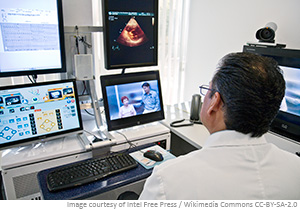
Technological advancements in medical care are happening with lightning speed these days and changing the delivery of healthcare. We've included "Advancements in Medical Care" among Sedgwick's Foresight for '14 topics and believe it will significantly affect employers this year.
I am often asked about technology and healthcare and how it could impact workers' comp. There are rich opportunities available to us, especially with the changes from the implementation of the Affordable Care Act.
The healthcare reform goals of greater efficiencies in the delivery of healthcare, better outcomes and more affordable pricing have raised discussions about newer technologies and workers' comp, especially telehealth. While it is not a new concept, it can have valuable new applications for our industry.
The American Telemedicine Association defines telehealth as remote healthcare technology to deliver clinical services. That can include anything from medical providers consulting by phone, to robotic surgery from a remote location.
More than 60% of health plans now include telehealth and the ATA estimates around 10 million Americans had a medical service provided remotely last year, although most were likely unaware of it. I see it as being especially effective in workers' comp situations for nurse triaging and clinical consultations.
Consider restaurants, for example, where burns are a fairly frequent occurrence. Using telehealth, a nurse at a remote location can evaluate the symptoms and determine whether the worker needs to be seen directly or can be discharged with instructions for homecare. The technology is sophisticated enough to allow the provider to see deep into the hair follicles – much more advanced than, say, Skype or FaceTime, and it is HIPAA compliant.
Telehealth could also be used to reduce or even eliminate waiting times, and thus costs, for injured workers to see medical specialists. A patient visiting his occupational healthcare provider who needs an evaluation from an orthopedist could have the consultation right on the spot, via a conference call during which results of diagnostic tests are projected onto a screen visible to the specialist.
Looking ahead, there is no reason the technology could not be used for roundtable discussions with medical providers, claims specialists, nurse case manager and the injured worker. In addition to cutting travel expenses and time, that would also address issues of transparency, since the patient would be a part of the conversation.
However there is one possible issue looming for telehealth that will need resolution. As reported in Modern Healthcare last month, "State boards' policy for telemedicine may present roadblocks" on physicians treating across state lines. This month, state boards will vote on various policies. It will be interesting to see how this plays out in the months to come.
What are your thoughts on the uses of telehealth in workers' comp? Are there other areas that should be explored?

Kimberly George, SVP, Senior Healthcare Advisor